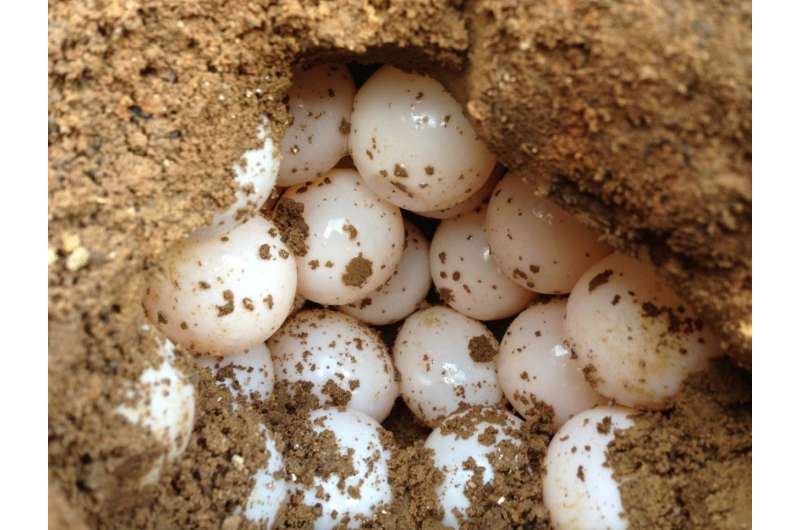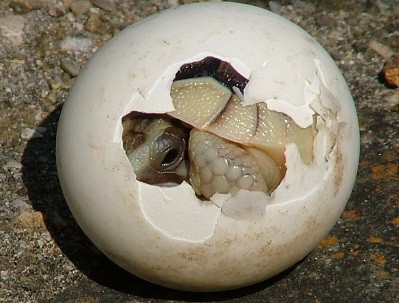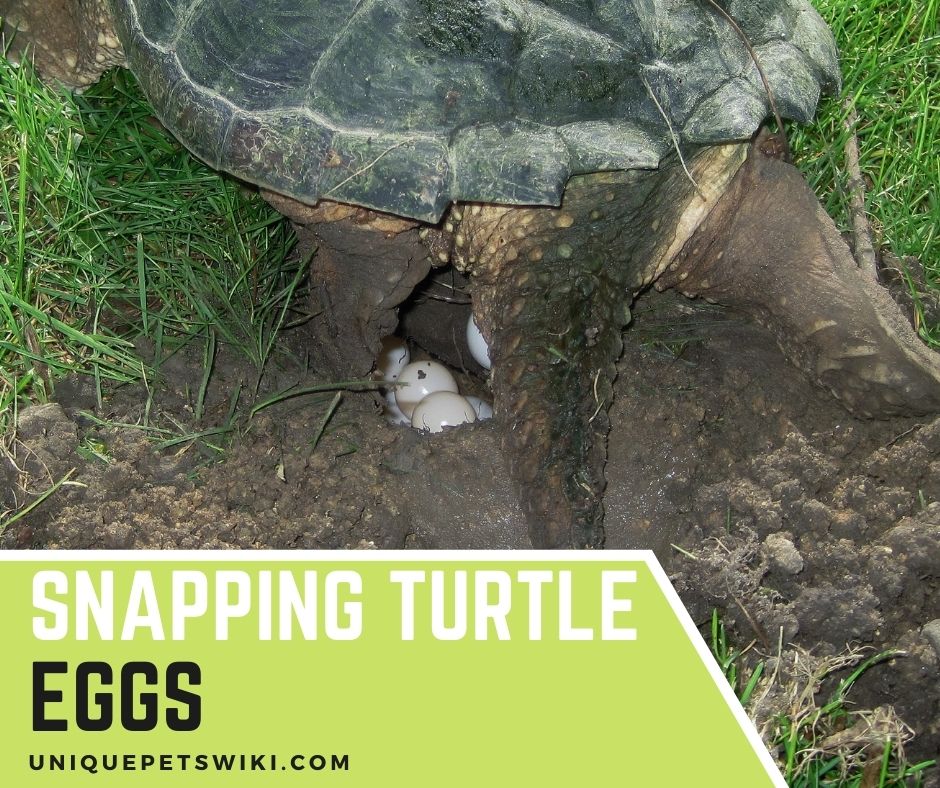Snapping turtles are aquatic animals found mainly in freshwater bodies. They are large-sized turtles with varying shell colors of tan, dark brown, and even black in some species.
Being oviparous animals, the female snapping turtles produce their young ones by laying numerous eggs.
They usually come out of the water bodies once a year to dig nests where they can lay their clutches. After laying the eggs, they’ll cover them with sand and walk back to the water.
Snapping turtles do not care for their young, hence, once the eggs successfully hatch, the hatchlings are on their own. By instinct, the hatchlings learn to survive.
As a result, hatchling/baby snapping turtles hardly make it through to adulthood without being preyed upon. This is one reason female snapping turtles lay large clutches of eggs in a single birth.
You might be wondering what a snapping turtle egg looks like. Actually, it is very simple to identify. Snapping turtle eggs have this unique shape and color that makes them different from other eggs. They are neither too big nor too small.
This article will unravel everything you need to know about identifying snapping turtle eggs and also taking good care of them till they hatch.
Contents
- When Do Snapping Turtles Lay Eggs?
- What Does A Snapping Turtle Egg Look Like? How To Identify Snapping Turtle Eggs
- How Long Do Snapping Turtle Eggs Take To Hatch?
- How Do You Know If Snapping Turtle Eggs Are Bad?
- How To Tell If Your Snapping Turtle Is Gravid/Pregnant And Ready To Lay Eggs
- How To Care For Snapping Turtle Eggs Till It Hatches
- How To Take Care Of A Baby Snapping Turtle
- Get And Prepare A New Tank
- Wrapping Up
When Do Snapping Turtles Lay Eggs?
Snapping turtles usually lay eggs in early summer (during the warmer months). In the wild, snapping turtles usually mate between April and November and would become gravid or active in breeding during the warmer months.
After the gestation period, they would leave the water to dig a nest for their eggs in a safe area on land. Since these animals have the capacity to store sperm and carry fertilized eggs for a long period of about 3years, very little is known about their gestation period.
Many animals, especially reptiles, have a mating and breeding season. This period is usually after brumation in summer or spring for some temperate zone reptiles. The same thing applies to tortoises and turtles.
These species of animals do have a certain period of the year where they mate with the opposite sex, fertilized the eggs or store up the sperm for some years, and then lay eggs in the warmer months.
A reproductive female snapping turtle as well as other species of turtles is able to store sperm in its body for several years.

What Does A Snapping Turtle Egg Look Like? How To Identify Snapping Turtle Eggs
The eggs of most animals are oval in shape, but snapping turtle eggs are round and white in color, similar to ping-pong balls.
As stated earlier, snapping turtle eggs are not too large nor too small; they are the size of a baseball.
When the female snapping turtle is about to lay her eggs, she usually leaves the water body to dig a nest in a safe place on the land about 5 to 7 inches deep and 2 to 3 inches wide.

How Long Do Snapping Turtle Eggs Take To Hatch?
Snapping turtle eggs normally incubate for about 90 – 120 days (3 – 4 months) and after which they will hatch. What time exactly, a clutch of eggs takes to hatch depends on the temperature of the environment. The warmer the temperature, the faster the process and vice versa.
Even with this, snapping turtle eggs do not all hatch at the same time, some would begin to hatch early from the 85th day while others follow Midway around the 90th to 110th day. This is to say that some eggs will hatch within 3 months and some will hatch later after 4 months.
However it takes for the eggs to hatch, you have to be patient and wait for all of them to hatch naturally on their own without trying to help them peel off the shell.
Furthermore, the environmental temperature also determines the sex of the hatchlings. Snapping turtles that hatch as males are incubated in a cooler temperature of about 68⁰ F while the eggs that hatch as females are incubated in a warmer temperature of between 73⁰ F to 75⁰ F.
Incubation temperature kept within 74⁰ F will result in the eggs hatching, some as females and some as males.
How Do You Know If Snapping Turtle Eggs Are Bad?
It is difficult, if not impossible to identify a bad egg from the good ones immediately after your snapping turtle lays her eggs. This is because the characteristic “dented and collapsed eggs” signs will not be visible until hatching starts. Also, how you handle the eggs prior to hatching can affect the viability of the eggs.
Unlike bird eggs, snapping turtle eggs should not be held up over a source of light to look out for signs of life. This is because shaking them or turning them upside down can kill the embryo thereby causing damage to the eggs.
If you don’t want to call on an expert veterinarian to examine the eggs, you can carefully lookout for the following common signs when you ventilate the eggs to know if they are still alive or not.
Dented Eggs
When you find out that your turtle eggs have a depressed scratch or are carved into the surface, it definitely means that the eggs are dented and will not hatch. The eggs must have been infertile all along or were fertile but the embryo died prematurely.
This happens when the eggs get dehydrated so you need to make sure that they are always moisturized.
Collapsed Eggs
Your turtle eggs could collapse because it has been fully saturated and drowned. Infertility can also cause some of the eggs to collapse. If they are collapsing within 2-3 days of being laid, that means there is definitely a problem with humidity. Even infertile eggs will last 3-5 weeks before they rupture, mold, or otherwise collapse.
Bugs
Seeing bugs on your turtle eggs is a clear indication that the eggs are decayed and bad. If you leave it among other eggs, it will contaminate them. So what you do is simply separate it from the clutch to save the life of other eggs.
As long as the eggs do not have the above-mentioned signs, it, therefore, means that they are healthy and growing just fine.
How To Tell If Your Snapping Turtle Is Gravid/Pregnant And Ready To Lay Eggs
If you’re new to snapping turtles, you would agree with me that it’s not easy to tell if these animals are pregnant with eggs.
The reason for this isn’t far-fetched, it is because snapping turtles, as well as other species of turtles, have the ability to store up sperm and fertilized eggs in their bodies for a longer time till when they are ready to lay the eggs (usually during the warmer months).
With this behavior, it makes it difficult for a keeper to say for certain that his snapping turtle is gravid or ready to lay her fertilized eggs.
Secondly, it’s also hard to tell if your pet snapping turtle is gravid since they don’t have a stomach that protrudes, rather, the eggs will be concealed in her hard shell.
That notwithstanding, by observing her behaviors, you can tell if your snapping turtle is gravid or not, or if your turtle is ready to lay some eggs or not. These behaviors include:
A General Change In Behavior
A pregnant snapping turtle, like every other animal, will exhibit some changes in her behavior when she is pregnant. Hence, if you haven’t been observing your snapper’s behaviors regularly, you may not know or notice when it’s acting differently.
A change in behavior of your snapping turtle can mean two things: it can either mean sickness or that your pet is gravid with some eggs.
A snapping turtle that is pregnant usually has a change in her basking routine. You would notice that your pet is always basking and attempts to leave the tank (the tank) or may completely stop basking.
Digging At The Basking Spot
Another sure-fire sign that your snapping turtle is pregnant is if you notice that it starts digging at the basking spot. By instinct, your pet is trying to secure a safe nest for her eggs.
However, you will only notice this behavior if you have a dry part in your snapper’s terrarium. If you’re keeping your pet in an “all water” aquarium, then you’ll need to look for other signs.
A Change In Her Eating Habits
Naturally, snapping turtles are known to be voracious eaters. However, when your pet snapper is pregnant, it’ll eat less and may even stop eating till she lays her eggs.
Besides a change in her eating habits, a pregnant snapping turtle will become very restless, pacing sporadically around its tank, and may even display some behaviors it never exhibited before.
Finger Testing To Feel The Eggs
Note that a change in behavior as discussed eggs earlier can also mean that your snapping turtle is sick. If you have ruled out sickness and suspect that your turtle is pregnant, simply confirm by feeling her under legs for eggs.
This is how you do that: using your fingers, gently press in the cavities that are between her legs and the plastron. Do that to both sides of the legs to feel if there are eggs. If she is carrying eggs, you’ll feel some hard little lumps or like small stones inside her stomach.
How To Care For Snapping Turtle Eggs Till It Hatches
As a keeper, your response to snapping turtle eggs is similar to a person who just discovered a clutch of snapping turtle’s eggs buried somewhere in his backyard or near the road.
Both persons are likely to show concern towards the eggs and proceed by making sure that the eggs are properly incubated till they hatch.
Therefore, if you’re not keeping snapping turtles as pets but want to know how to safely transport their eggs to a safer place for incubation, it’s much easier to achieve that.
This section guides you through how to safely transport snapping turtle eggs and incubate them till they hatch.
Hatching snapping turtle eggs usually takes about 80-90 days depending on the season and temperature of the environment at the time.
In the wild, snapping turtle eggs that are allowed to remain where the mother snapping turtle laid them and are allowed to hatch naturally, hardly survived due to factors such as; being eaten by predators, being affected by cold weather, and being trampled on by pedestrians.
These factors are responsible for snapping turtle eggs not making it to the hatching stage. For this reason, if you come across snapping turtle eggs buried somewhere that is not safe, you can decide to save the eggs by taking them away from that spot to a safer place.
It is not quite easy to move the eggs out of their nest. You don’t just dig out eggs and scoop them out of the hole without taking adequate precautions. If you move them anyhow, you’ll lose the entire clutch of eggs because none of them will hatch.
There are three steps to follow when trying to save snapping turtle eggs, on discovering them.
References: how to care for turtle eggs
Moving The Eggs To A Safe Spot
Before you move them out of their original spot, you have to prepare an incubator or buy an already-made incubator if you have the money.
When you have gotten your incubator ready, carefully remove the eggs from the nest, taking into consideration the original position that the eggs were laid.
You can use a non-chemical marker to mark the top of the eggs so that when inserting them into the incubator, you’ll be sure that you have not turned them upside down or shaken them.
Inserting The Eggs Into The Incubator
On getting an incubator, you must make sure that the temperature and humidity inside it can be controlled, the temperature must remain at 27 C while the humidity must be at 80%. This will determine how long or short the incubation process will be.
It is important to note that the temperature of an incubator determines the sex of the hatchlings.
Lower temperature will produce male baby turtles, average temperature produces both genders while temperatures maintained at higher degrees will produce female baby turtles.
Turtle Eggs Incubation
When you have successfully arranged the eggs in the incubator, you just have to be patient and keep a watch on the eggs for a few months for them to hatch. During this period, avoid touching the eggs or carrying them so that the embryo will not die.
When the eggs begin to crack, it’s not advisable to help break them open, the hatchlings will eventually break out on their own.
After hatching, baby snapping turtles often come out with an egg sac attached to their bodies, it is not also advisable to remove them out of the incubator until after two days when the egg sac is completely gone off.

How To Take Care Of A Baby Snapping Turtle
When the babies finally break out of their shells, try not to pick them up because they need to remain in the eggshell for a few days till they have absorbed the egg yolk from the sac attached to their stomachs.
The sac usually looks yellowish-orange in color and this egg sac is very important to the hatchlings since that is where they get their nutrients from for the first few days of their lives. During this time, you don’t need to feed them.
One other reason you should avoid picking up the baby turtles as soon as they hatch is because the egg sac attached under their belly is very sensitive and can get torn from a sharp piece of eggshell. If the sacs get torn in any way, the babies will catch an infection and may die.
Once the babies are completely out of the shell, carefully pick them and move them into a new container lined with wet paper towels. The babies will do just fine in the container for about a week until the egg sac is completely absorbed.
Meanwhile, you can sprinkle some water on the paper towel to keep it moist. Then you follow the steps below to prepare a suitable place for them.
Get And Prepare A New Tank
It is not quite a difficult task to prepare an aquatic tank habitation for your baby turtles. First of all, you need to get a 10-gallon aquarium, if it is just one, but as it grows you need to get a bigger gallon tank.
Fill the gallon with water that is deep enough to cover the turtle’s shell. Line the bottom of the tank with smooth river rocks, sticks, and plants.
Your turtle will need an island or a shallow flat stone and would also feel safer when trying to hide among the accessories. Your pet will also need access to a heated basking area outside of the water.
Install A Heat Lamp
Although snapping turtles can cope with sudden temperature changes and would also survive in cold waters, you have to get a lamp and place it over the shallowest area of the tank to regulate ambient air temperature above the water.
It’s also advisable to maintain the temperature of the aquarium beneath at a range of 78⁰ F to 82° F using a heater. This temperature can be achieved with underwater heaters.
A thermometer should be placed near the heater at both ends of the tank to ensure the temperature gradients don’t move outside the ideal range.
Provide Them With Suitable Diet
Being omnivores, snapping turtles do not select food. They can eat a variety of meals that are offered to them. But you can just buy turtle food like mealworms, guppies, and ghost shrimp.
They can also eat homemade food like fish, beef, chicken, and turkey. Adding vegetables, lettuces, and greens to their diet would be even more nutritious.
Wrapping Up
Snapping turtles are tan, dark-brown, or black shelled turtles from the Chelydra family. They are mostly found in Northern America (which is why they are nicknamed “only found in America”).
They are oviparous in nature, meaning that they produce their young ones by laying eggs. It could be quite exciting and fascinating to incubate snapping turtle eggs and then watch the tiny little babies crack out of their eggs.
Keeping them is not very tasking, except the period where you have to tell if your female is gravid and ready to lay eggs or even dig the eggs out and put them into an incubator.
You could lose the entire clutch if you don’t take into consideration the orientation of the eggs in their original spot or if you didn’t know in time that your female was gravid and wants to lay eggs.
Nonetheless, if you’ve successfully hatch snapping turtle eggs to babies, you just have to make sure that the hatchlings are provided with the necessary habitat and diet that will simulate their natural habitat.
